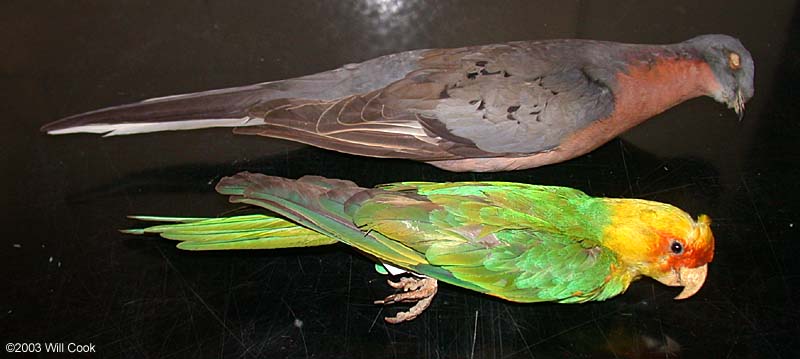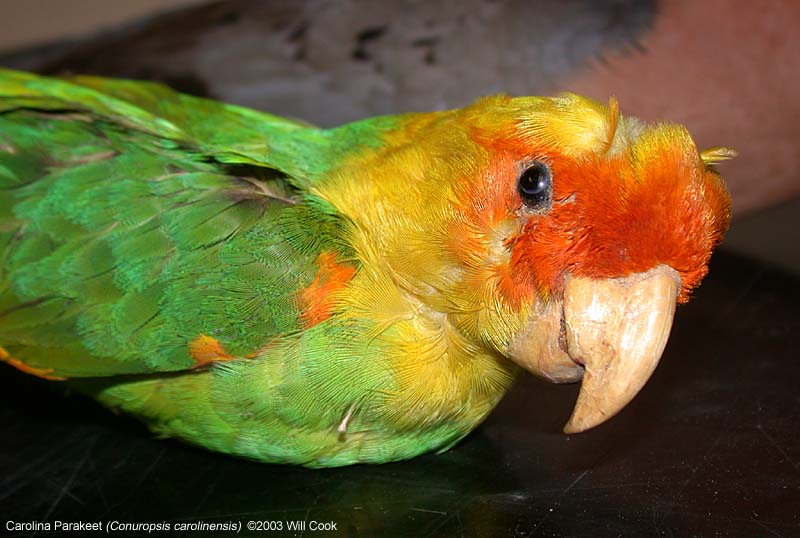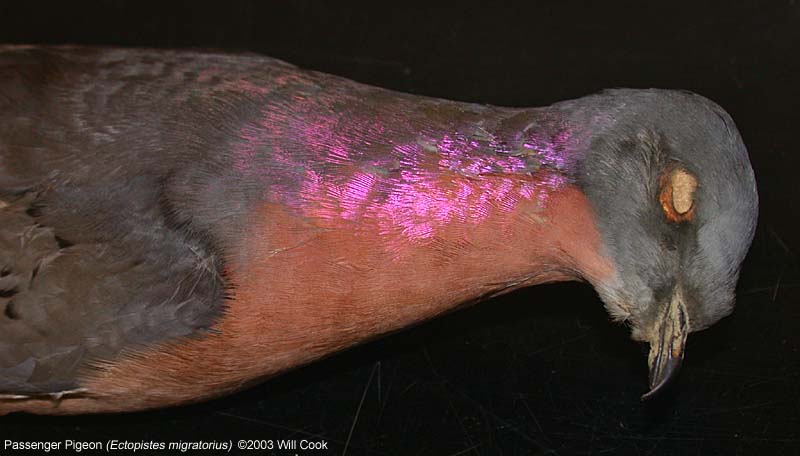This day, one of our Company, with a Sapona Indian, who attended Stewart, went back for the Horses. In the mean time, we went to shoot Pigeons, which were so numerous in these Parts that you might see many Millions in a Flock; they sometimes split off the Limbs of stout Oaks, and other Trees, upon which they roost o' Nights. You may find several Indian Towns, of not above 17 Houses, that have more than 100 Gallons of Pigeons Oil, or Fat; they using it with Pulse, or Bread, as we do Butter, and making the Ground as white as a Sheet with their Dung. The Indians take a Light, and go among them in the Night, and bring away some thousands, killing them with long Poles, as they roost in the Trees. At this time of the Year, the Flocks, as they pass by, in great measure, obstruct the Light of the day.
Our wild Pigeons, are like the Wood-Queese or Stock-Doves, only have a longer Tail. They leave us in the Summer. This sort of Pigeon (as I said before) is the most like our Stock-Doves, or Wood-Pigeons that we have in England; only these differ in their Tails, which are very long, much like a Parrakeeto's? You must understand, that these Birds do not breed amongst us, (who are settled at, and near the Mouths of the Rivers, as I have intimated to you before) but come down (especially in hard Winters) amongst the Inhabitants, in great Flocks, as they were seen to do in the Year 1707, which was the hardest Winter that ever was known, since Carolina has been seated by the Christians. And if that Country had such hard Weather, what must be expected of the severe Winters in Pensylvania, New-York, and New-England, where Winters are ten times (if possible) colder than with us. Although the Flocks are, in such Extremities, very numerous; yet they are not to be mention'd in Comparison with the great and infinite Numbers of these Fowl, that are met withal about a hundred, or a hundred and fifty, Miles to the Westward of the Places where we at present live; and where these Pigeons come down, in quest of a small sort of Acorns, which in those parts are plentifully found. They are the same we call Turky-Acorns, because the wild Turkies feed very much thereon; And for the same Reason, those Trees that bear them, are call'd Turky-Oaks. I saw such prodigious Flocks of these Pigeons, in January or February, 1701-2, (which were in the hilly Country, between the great Nation of the Esaw Indians, and the pleasant Stream of Sapona, which is the West-Branch of Clarendon, or the Cape-Fair River) that they had broke down the Limbs of a great many large Trees all over those Woods, whereon they chanced to sit and roost; especially the great Pines, which are a more brittle Wood, than our sorts of Oak are. These Pigeons, about Sun-Rise, when we were preparing to march on our Journey, would fly byus in such vast Flocks, that they would be near a Quarter of an Hour, before they were all pass'd by; and as soon as that Flock was gone, another would come; and so successively one after another, for great part of the Morning. It is observable, that wherever these Fowl come in such Numbers, as I saw them then, they clear all before them, scarce leaving one Acorn upon the Ground, which would, doubtless, be a great Prejudice to the Planters that should seat there, because their Swine would be thereby depriv'd of their Mast. When I saw such Flocks of the Pigeons I now speak of, none of our Company had any other sort of Shot, than that which is cast in Moulds, and was so very large, that we could not put above ten or a dozen of them into our largest Pieces; Wherefore, we made but an indifferent Hand of shooting them; although we commonly kill'd a Pigeon for every Shot. They were very fat, and as good Pigeons, as ever I eat. I enquired of the Indians that dwell'd in those Parts, where it was that those Pigeons bred, and they pointed towards the vast Ridge of Mountains, and said, they bred there. Now, whether they make their Nests in the Holes in the Rocks of those Mountains, or build in Trees, I could not learn; but they seem to me to be a Wood-Pigeon, that build in Trees, because of their frequent sitting thereon, and their Roosting on Trees always at Night, under which their Dung commonly lies half a Foot thick, and kills every thing that grows where it falls.
The Parrakeetos are of a green Colour, and Orange-Colour'd half way their Head. Of these and the Allegators, there is none found to the Northward of this Province. They visit us first, when Mulberries are ripe, which Fruit they love extremely. They peck the Apples, to eat the Kernels, so that the Fruit rots and perishes. They are mischievous to Orchards. They are often taken alive, and will become familiar and tame in two days. They have their Nests in hollow Trees, in low, swampy Ground. They devour the Birch-Buds in April, and lie hidden when the Weather is frosty and hard.



